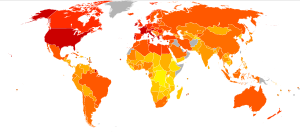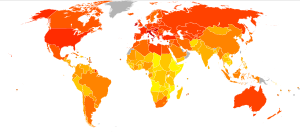- Dietary energy supply
-
The dietary energy supply is the food available for human consumption, usually expressed in kilocalories per person per day. It gives an overestimate of the total amount of food consumed as it reflects both food consumed and food wasted.[1] It varies markedly between different regions and countries of the world. It has also changed significantly over the 21st century. Dietary energy supply is correlated with the rate of obesity.[2]
Contents
Regions
Region 1964-1966 1974-1976 1984-1986 1997-1999 World[3] 2358 kcal/day 2435 kcal/day 2655 kcal/day 2803 kcal/day Sub Saharan Africa[3] 2058 kcal/day 2079 kcal/day 2057 kcal/day 2195 kcal/day Countries
Country 1979-1981 1989-1991 2001-2003 Canada[4] 2930 kcal/day 3030 kcal/day 3590 kcal/day China[5] 2330 kcal/day 2680 kcal/day 2940 kcal/day Swaziland[6] 2400 kcal/day 2450 kcal/day 2360 kcal/day United Kingdom[7] 3170 kcal/day 3250 kcal/day 3440 kcal/day United States[8] 3180 kcal/day 3460 kcal/day 3770 kcal/day References
- ^ "Compendium of food and agriculture indicators - 2006". FAO. http://www.fao.org/statistics/compendium_2006/concepts.asp. Retrieved February 18, 2009.[dead link]
- ^ Moussavi N, Gavino V, Receveur O (November 2008). "Is obesity related to the type of dietary fatty acids? An ecological study". Public Health Nutr 11 (11): 1149–55. doi:10.1017/S1368980007001541. PMID 18194589.
- ^ a b "Global and regional food consumption patterns and trends". FAO. http://www.fao.org/docrep/005/AC911E/ac911e05.htm.
- ^ "www.fao.org". http://www.fao.org/statistics/compendium_2006/pdf/CAN_ESS_E.pdf.
- ^ "www.fao.org". http://www.fao.org/statistics/compendium_2006/pdf/CPR_ESS_E.pdf.
- ^ "www.fao.org". http://www.fao.org/statistics/compendium_2006/pdf/SWA_ESS_E.pdf.
- ^ "www.fao.org". http://www.fao.org/statistics/compendium_2006/pdf/UKM_ESS_E.pdf.
- ^ "www.fao.org". http://www.fao.org/statistics/compendium_2006/pdf/USA_ESS_E.pdf.
See Also
External links
- Food and Agriculture Organization of the United Nations (1996). The Sixth World Food Survey 1996. Food & Agriculture Org. ISBN 92-5-103837-6.
Categories:- Obesity
- Diets
Wikimedia Foundation. 2010.



